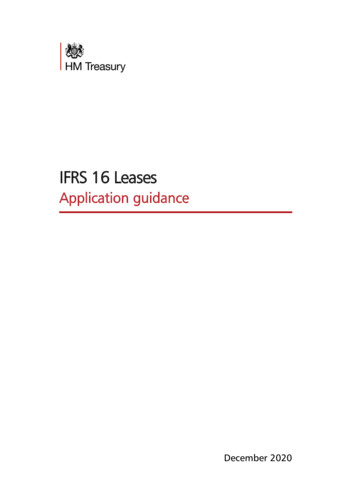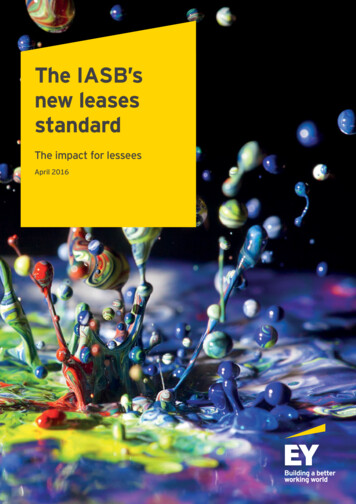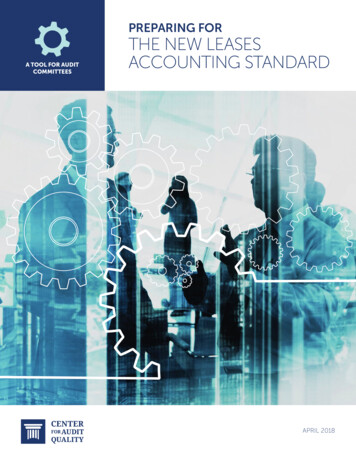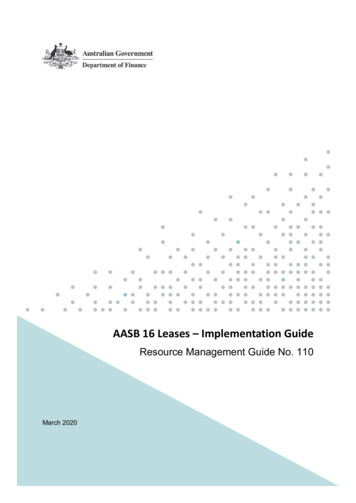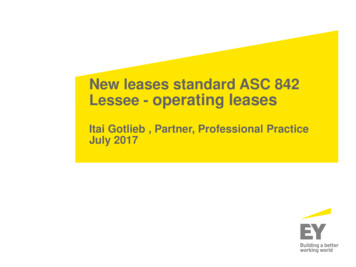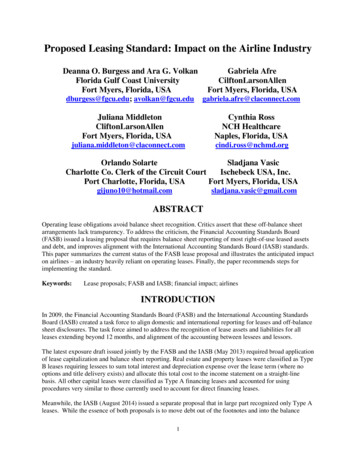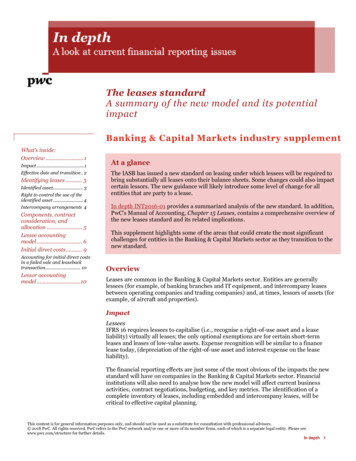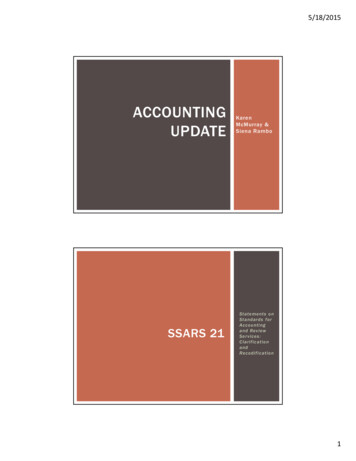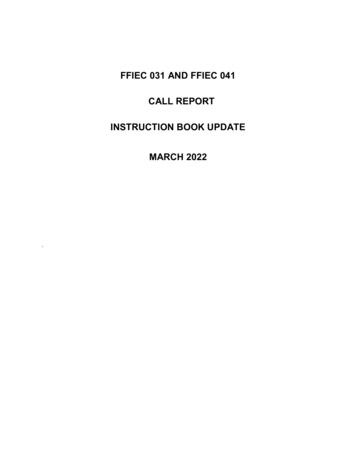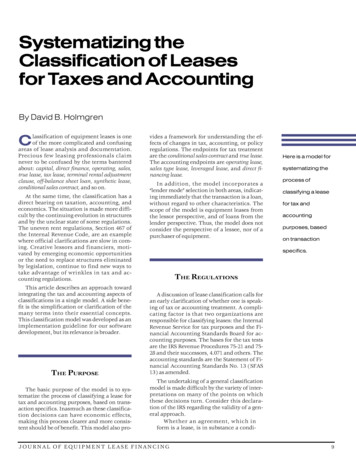
Transcription
Systematizing theClassification of Leasesfor Taxes and AccountingBy David B. Holmgrenlassification of equipment leases is oneof the more complicated and confusingareas of lease analysis and documentation.Precious few leasing professionals claimnever to be confused by the terms banteredabout: capital, direct finance, operating, sales,true lease, tax lease, terminal rental adjustmentclause, off-balance sheet loan, synthetic lease,conditional sales contract, and so on.CAt the same time, the classification has adirect bearing on taxation, accounting, andeconomics. The situation is made more difficult by the continuing evolution in structuresand by the unclear state of some regulations.The uneven rent regulations, Section 467 ofthe Internal Revenue Code, are an examplewhere official clarifications are slow in coming. Creative lessors and financiers, motivated by emerging economic opportunitiesor the need to replace structures eliminatedby legislation, continue to find new ways totake advantage of wrinkles in tax and accounting regulations.This article describes an approach towardintegrating the tax and accounting aspects ofclassifications in a single model. A side benefit is the simplification or clarification of themany terms into their essential concepts.This classification model was developed as animplementation guideline for our softwaredevelopment, but its relevance is broader.vides a framework for understanding the effects of changes in tax, accounting, or policyregulations. The endpoints for tax treatmentare the conditional sales contract and true lease.The accounting endpoints are operating lease,sales type lease, leveraged lease, and direct financing lease.In addition, the model incorporates a“lender mode” selection in both areas, indicating immediately that the transaction is a loan,without regard to other characteristics. Thescope of the model is equipment leases fromthe lessor perspective, and of loans from thelender perspective. Thus, the model does notconsider the perspective of a lessee, nor of apurchaser of equipment.Here is a model forsystematizing theprocess ofclassifying a leasefor tax andaccountingpurposes, basedon transactionspecifics.THE REGULATIONSTHE PURPOSEA discussion of lease classification calls foran early clarification of whether one is speaking of tax or accounting treatment. A complicating factor is that two organizations areresponsible for classifying leases: the InternalRevenue Service for tax purposes and the Financial Accounting Standards Board for accounting purposes. The bases for the tax testsare the IRS Revenue Procedures 75-21 and 7528 and their successors, 4.071 and others. Theaccounting standards are the Statement of Financial Accounting Standards No. 13 (SFAS13) as amended.The basic purpose of the model is to systematize the process of classifying a lease fortax and accounting purposes, based on transaction specifics. Inasmuch as these classification decisions can have economic effects,making this process clearer and more consistent should be of benefit. This model also pro-The undertaking of a general classificationmodel is made difficult by the variety of interpretations on many of the points on whichthese decisions turn. Consider this declaration of the IRS regarding the validity of a general approach.Whether an agreement, which inform is a lease, is in substance a condi-JOURNAL OF EQUIPMENT LEASE FINANCING9
tional sales contract depends on the intent of the parties as evidenced by theprovisions of the (lease or transaction)agreement, read in the light of the factsand circumstances existing at the timethe agreement was executed. In ascertaining such intent, no single test or anyspecial combination of tests is absolutely determinative. No general rule,applicable to all cases, can be laid down.Each case must be decided in the lightof its particular facts.1No single test orgeneral rule canbe laid down,according tothe IRS.TAX PHASEThe classification model, shown in Figure 1,begins with the tax phase, whose objective isto identify whether the transaction is a truelease or a conditional sales contract for tax purposes. (Both this and the accounting phaseinclude choices for the user to arbitrarily select the endpoints.) This distinction has a material economic effect, as the components oftaxable income for the owner/lessor are determined as follows:Despite this discouraging prologue, we setout to make the best of our endeavor. To theIRS’s credit, it recognizes the existence of principles that are generally compelling in the absence of contradictory indications. Thismodel encompasses some of these principles. True lease: MACRS depreciation tax benefits are allowed as deductions from taxableincome, interest paid is deductible, andrent and residual are taxable income. Conditional sales contract: Cash inflows toFigure 1TAX CLASSIFICATIONBeginTAX efaultCSCLeverage 80%YesConditonalSales Contract75-21TestsNoLeverage 50%FailYesOptionally ignore 75-21 testsbecause not esPutNoLesseeGuaranteeYesNoBargainPurchaseYesNo3rd seNoYesNoRem.E-LifeRem.E-ValueNoUnevenRent TestFailUserChoiceAdjust RentsTrueLeaseLevel per 467Ignore Failure10VOL. 15/NO. 2 FALL 1997
the lessor are split into principal and interest components. The interest is taxable income. The residual is considered a balloonpayment, and there are no deductions fordepreciation. There may be a gain at execution of the contract in the event of an excessof the deemed sales price over the cost.are performed. If any one fails, the transaction is assumed to be a conditional sale andfurther tests are skipped.As a guideline, ifThe profit test checks whether the transaction, exclusive of tax benefits, produces aprofit. Adding the total rents and the estimated residual, and subtracting the disbursements of principal and interest payments,equity, and fees performs this. If the result ispositive, the test is passed.The tax testing continues with a check ofleverage: If it is over 80 percent, conditionalsale is immediately assumed. This is due tothe lessor’s having less than 20 percent at risk.This value is only a guideline; smalleramounts may be acceptable, depending on thenature of the asset or the industry.leverage is over 80percent, conditionalsale is assumed.The cash-flow test determines whethertotal rent less debt service and fees is “reasonable,” which typically is taken to mean 2 percent of the equity per year. Finally, theminimum equity test checks whether the freecash is received “too quickly.” This is done byadding the equity to a prorated amount ofprofit at each point in the lease and comparing that to the cumulative profit to that point.The prorating is usually proportional to thepercentage of the lease term.Lower thresholds are frequently used forhigh-tech equipment in particular. If leverageis less than 50 percent, then the 75-21 tests canoptionally be bypassed, as inapplicable tononleveraged leases. Within the range of 50percent to 80 percent, these tests — profits test,cash-flow test, and the minimum equity test —Figure 2ACCOUNTING odeLoanYesNoUserChoiceSFAS 13TestsSales rchaseLeveragedYesYesNoYesYesStartin last qtr.of E-lifeNoLT 3/4 E-lifeCapitalLeaseCost Fair ValueYesLeveragePresentYesNoYesSingle InvestorNoMLP 90%NoOperatingE-Life Economic LifeE-Value Economic ValueMLP Minimum Lease PaymentsJOURNAL OF EQUIPMENT LEASE FINANCING11
Some Judgmental TestsA bargain purchaseoption is a provisionallowing the lesseeto purchase theequipment for anamount less than itsfair market value.This is seen aseconomicallycompelling andthereforedeterminesconditional sale.The model then proceeds to tests that aresomewhat judgmental rather than quantifiable and measurable. Specifically, these arethe presence of a put, a lessee residual guarantee, bargain purchase option, third-party guarantee, security deposit, and limited use property.If any of these applies, then the transaction isdeemed a conditional sale and flow proceeds tothe accounting phase, bypassing the remaining tax tests. (Some of these tests use thresholds for determining whether the test passes.)A put is a clause allowing the lessor to forcethe lessee to purchase the equipment, and alessee residual guarantee is an assurance thatthe lessee will guarantee a certain portion ofthe residual value. Both indicate that thelessor is not carrying the full residual risk orthat the lessee has an economic interest in theequipment beyond the lease term. Dependingon transaction particulars, either may determine conditional sale.A bargain purchase option is a provision allowing the lessee to purchase the equipmentfor an amount less than its fair market value.This is seen as economically compelling andtherefore determines conditional sale. Whethera purchase option is a bargain is determined inthe model by a simple comparison of the purchase option amount to the fair market value; ifit is less, it is a bargain purchase.A third-party guarantee is an assurance —often in the form of insurance coverage — by aparty not related to the lessee or lessor to pay acertain portion of the residual. This guaranteemay apply to the top or bottom of the expected residual value. The first covers theshortfall (up to the amount of insurance) between the actual proceeds and the insuredresidual. The second is coverage to preventthe realized value from dropping below a certain insured amount, regardless of the expected residual value.An arm’s length agreement to protect eitherend is a fairly standard arrangement andshould not affect true lease status, especially ifa significant portion of the expected residualremains unguaranteed or if the lessor retainsfirst-loss exposure. In the model, 10 percent isused as a simplistic guideline for this test, butthis area is subject to a variety of interpretations by lessors and their tax counsel.A security deposit is a significant amount(10 percent or more of equipment cost) paidby the lessee and held by the lessor during thelease. Closely related to a security deposit isan investment by the lessee in the lessor’s operation, or particularly in the initial fundingof the equipment. Such an investment could12mean that the lessor is carrying less than thefull risk commensurate for true lease benefits.This, too, decides for conditional sale.Next, the model tests whether the equipment is limited use property, a somewhat subjective point. If a reasonable interpretationindicates that its use is limited to the particular lessee, application, or facility, then thelessor would probably be seen as having asubstantial interest in continuing the economic relationship with this lessee, either as asale or a renewed lease. This also determinesconditional sale.Finally, two tests are applied relating to theremaining usefulness of re-leased equipment.First, the remaining economic life is compared to 10 percent of the full economic life(or alternatively, 20 percent, depending on thetype of equipment), and the remaining economic value is compared to 10 percent or 20percent of the original value (choice of testvalue to be consistent with the preceding test).If either is less than the comparison value, thetransaction is deemed a conditional sale. Thisrecognizes the circumstance that this leasewill likely be the last for this equipment, sothe lessor will have nothing more at risk, or,expressed differently, the remaining economic value will be consumed by this lease.If all of these tests are passed without conditional sale having been determined, then truelease is concluded. The only remaining taxquestion is whether the rents meet the unevenrent test. A complete discussion of this test goesbeyond the scope of this article, but in generalthe test is passed if each year’s rent falls within10 percent of the average annual rent.For purposes of our model, the user has afurther choice of how to handle a failure: ignore it or adjust the rents. Adjusting themmeans leveling them per the regulations inSection 467. (It does not disqualify the truelease status.)ACCOUNTING PHASEThe purpose of the accounting phase is toarrive at one of the endpoints—loan treatment,sales type lease, leveraged lease, direct financinglease, and operating lease. This (see Figure 2)decision will determine the lessor’s balancesheet and income statement treatment. Capital lease is the collective designation for salestype, leveraged, and direct financing. The intentof the capital lease designation is to recognizeVOL. 15/NO. 2 FALL 1997
. that a lease which transfers substantially all of the risks and benefits incident to the ownership of propertyshould be accounted for as the acquisition of an asset and the incurrence of anobligation by the lessee and as a sale orfinancing by the lessor.2Like the tax classification process, the accounting phase begins with the lender modequestion. If affirmative, loan treatment is decided and there are no further tests. The modelthen provides a choice for the user to select theaccounting treatment, but in the default casethe SFAS 13 tests are performed. Passing anyone of these four makes the lease a capitallease. If none is met, it is an operating lease.The first test is title transfer. The concepthere is that if the documents state that title tothe asset will transfer from lessor to lessee,then the parties should account for the transaction as if it were a sale, since the lessee is assuming the risks and benefits of ownership.The test for a bargain purchase option issimilar although less definitive. (Less definitive because the question of whether a purchase option constitutes a bargain may besubjective.) A bargain purchase option indicates that the lessee is entitled to purchase theequipment for an amount significantly lessthan the fair market value. Since it is reasonable to expect the lessee to exercise such anoption, the lessee in effect has taken on therisks and benefits of ownership, and the transaction qualifies as a capital lease.Then the model tests whether the lease begins in the last quarter of the economic life ofthe asset. If so, it is an operating lease. This isbecause there is no particular need to accountfor an asset on the balance sheet if its valuehas already been substantially consumed. Ifthat is not the case, but the lease term is atleast three-fourths of the economic life, then itis a capital lease. This is because the lease consumes the substantial value of the asset.Finally, it is a capital lease if the presentvalue of the minimum lease payments (MLP)is at least 90 percent of the equipment cost(discounted typically at the interest rate implicit in the lease). This tests whether thelessee’s rent and other obligations to thelessor (such as a partial third-party residualguarantee) under the lease comprise a substantial portion of the equipment cost. Thistest is crucial in many structuring situations.The capital lease designation is brokendown by two further tests. First, is the fairvalue of the equipment equal to the cost? If notequal (that is, profit is generated), the transaction is deemed a sales type lease. If equal, a direct finance lease is concluded. This is theumbrella term for leveraged and single investorleases, which are then distinguished in themodel by whether the leverage is 50 percent ormore—leveraged—or less—direct financing.Like the taxclassificationprocess, theaccounting phaseCENTRAL DECISION CONCEPTSStudy of this flow process should help illustrate that certain principles are central decision concepts in lease classification. One iswhether the lease transfers the substantialeconomic value of the asset to the lessee. Another is whether the lessor is adequately atrisk to be entitled to true lease tax benefits,and whether the transaction is “legitimate”(i.e., makes a profit) exclusive of tax benefits.The financial participation or commitment ofthe lessee is also key.begins with the lendermode question. Ifaffirmative, loantreatment is decidedand there are nofurther tests.Nevertheless, the process is complex andindeed its quirks are a source of creative structuring for financiers. For example, a syntheticlease (in which the documents describe alease, but the lessee is the tax owner) turns onthe ability to account for it as a lease but totreat it as a loan for tax purposes.This model is intended to systematize theclassification of leases from the perspectivesof taxation and accounting. The purpose ofthe tax phase is to determine whether a transaction is a lease or a conditional sales contract.The purpose of the accounting phase is to determine whether a transaction is a loan, an operating lease, or a capital lease, with threesubcategories for capital: sales type, leveragedlease, and direct financing lease.The model should address most companies’ needs as is, although individual customizations are easily accommodated. Forexample, for the tests that use a thresholdvalue (e.g., 10 percent to consider a securitydeposit significant), the model can providefor user input of the threshold.Endnotes1Revenue Ruling 55-540, Section 4.2SFAS 13, Para. L10. 103.David B. Holmgren is a senior financial analystwith the Walnut Creek, Calif.-based Ivory Consulting Corp., where he specializes in technical consulting and quality control. Ivory develops andmarkets the SuperTRUMP lease analysis product.JOURNAL OF EQUIPMENT LEASE FINANCING13
JOURNAL OF EQUIPMENT LEASE FINANCING 9 vides a framework for understanding the ef-fects of changes in tax, accounting, or policy regulations. The endpoints for tax treatment are the conditional sales contractand true lease. The accounting endpoints are operating lease, sales type lease, leveraged lease,and direct fi-nancing lease.


